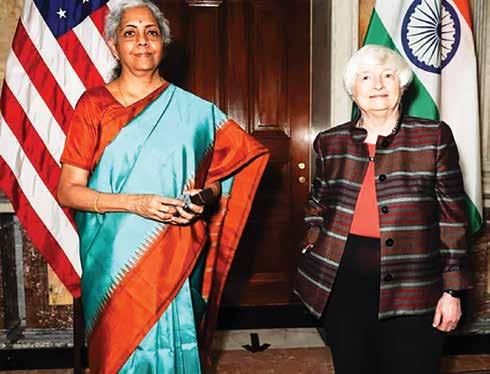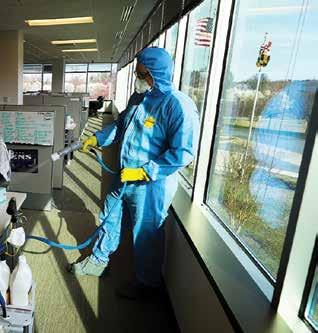
47 minute read
TRENDS
COVID-19 CHANGES THE LANDSCAPE OF
CSR IN INDIA
Advertisement
Though there is no universally accepted definition of Corporate Social Responsibility (CSR), the core of the concept however, is structured around the belief that businesses have a sense of responsibility towards society and the people from whom they derive their success. In countries such as India, where economic integration and social inclusion are imperative forces that drive the masses towards growth and development CSR has become an integral and impactful part of corporate landscape.
A total of INR 71, 277 Cr have been spent on 1,05,358 CSR projects till FY2019. The top three domains receiving maximum funding are education, health and rural development.
Another area receiving signifcant funding is environmental sustainability. Another interesting trend is that signifcant amounts of funding go to higher industrialised states. Since FY 2015, Maharashtra, Karnataka, Gujarat and Tamil Nadu have received more than 30 per cent of the total CSR spend. Government of India declared the novel coronavirus outbreak in the country a “notifed disaster” to enable state governments to mobilise resources from the State Disaster Response Funds (SDRF). Following the notifcation, the Ministry of Corporate Affairs (MCA) clarifed that spending of funds for COVID-19 relief would be a permissible activity under CSR.
Again, the MCA advised that the activities should be interpreted liberally so as to capture the essence of the activities permitted under the Schedule. The government has also set up the ‘Prime Minister’s Citizen Assistance and Relief in Emergency Situations Fund’ (PM CARES) to respond to the COVID-19 crisis and provide relief to those affected. Further, Schedule VII was amended to include contributions to PM CARES as CSR along with the existing Prime Minister’s National Relief Fund.

Tapping into its vast network and relationships, Invest India set up a CSR specifc assistance cell to assist corporates to channel their CSR funding into various governmental and non-governmental organisations as well as central and statelevel funds set up for the specifc task of COVID-19 relief. To support contributions to relief funds across both the centre and states, Invest India created an online repository of 30+ relief funds as well as developed a pipeline of INR 163 Cr in donations and CSR contributions from corporates.
This enabled corporates and volunteers to locate and connect with organisations needing monetary or other support in their activities. Another key enablement function for Invest India’s COVID-19 response was the facilitation of donations of essential supplies, over 10,86,100 pieces of PPEs, critical care equipment and other commodities to frontline organisations.
To shed light on an aspect of corporate India that is often overlooked Invest India has written this report. It presents a broad overview of the changing landscape of CSR in India especially during COVID-19 along with learning from our engagements and insights into key trends. It also features the role of CSR for technological incubators as an instrumental stride in the battle against COVID-19.
This report is based on our analysis from primary research, through a survey of companies and government incubators. The secondary data was collected through

company annual reports, MCA notifcations, and reports on CSR in India.
Contribution by the corporate sector:
According to the Report of the HighLevel Committee on Corporate Social Responsibility 2018, the number of reporting companies that carry CSR obligation has steadily increased in 2014-15 to 2016-17 and then declined in the year 2017-18. The total CSR expenditure by these companies increased substantially by 44 per cent from 2014-16 and thereafter marginally declined in 2016-17.
This has been highlighted in the table below. It has also been observed that the average spend by a government enterprise on CSR varied between INR 8-10 Cr per company between 2014-15 to 2017-18 whereas the average spend by a private company steadily increased from INR 72 Lakh per company in 2014-15 to INR 95 Lakh per company in the year 2017-18.
Changing trends after the outbreak of COVID-19
COVID-19 has been considered a global pandemic by the World Health Organization (WHO). The contagious disease tremendously disrupted socioeconomic circumstances of the planet. Social-distancing played a pivotal role in mitigating the spread of this deadly infection.
The Government of India and state governments announced lockdowns throughout the country in March 2020 in order to promote social distancing, which basically directed the public to maintain distance both socially and physically.
Extended lockdowns worsened economic troubles. Heavy population and a lack of awareness (due to a lack of education) added to the problems. Here comes the importance of CSR, which played a crucial role in the times of this pandemic, when people are trying their level best to get through the challenging times.
CSR is a ‘self-regulating business model’ that implies the procedures of interaction by a company with its stakeholders and the general public at large, creating a scenario of being socially responsible.
According to Section 135 of Companies (CSR) Rules, 2014 and Schedule VII of Companies Act 2013: Every company with a net worth of INR 500 crore or more or turnover of INR 1,000 crore or more or net profit of INR 5 crore or more during the immediate preceding financial year, must have a CSR committee and spend at least 2 per cent of average net profits earned during three immediate preceding financial years to CSR activities.
In the present era of COVID-19, the Government of India is inspiring companies to provide social support. According to a March 23, 2020 Ministry of Corporate Affairs circular, all expenditures incurred on activities related to COVID-19 would be added as permissible avenues for CSR expenditure. Funds may be spent for various activities related to COVID-19, under the following items of Schedule VII:
• Eradicating hunger • Poverty • Malnutrition • Promoting healthcare, including preventive healthcare • Sanitation, including contribution to the Swachh Bharat Kosh set up by the
Centre for promoting sanitation and making available safe drinking water • Disaster management, including relief, rehabilitation and reconstruction activities
Further, A general circular (No. 21/2014, dated June 18, 2014) mentioned that the items in Schedule VII are broad-based and may be interpreted liberally for the purpose of donations being made with respect to COVID 19. This announcement from the ministry was welcomed by Corporate India. It created a win-win situation for companies with existing CSR obligation and funds at disposal who wanted to contribute to relief and meet statutory requirements of The Companies Act at the same time.
The response to the government’s call to support COVID-19 efforts has been overwhelming. Crores have been donated to various government funds. Considering the huge sum of funds at stake for the relief efforts, corporates are struggling not just in finding a reliable implementing partner but also in figuring out a way to monitor and track the use of the donated funds and assessing their impact.
With the announcement by the government that any amount donated by companies in support of the fight against COVID-19 will qualify as CSR, a majority of the companies either contributed to the PM CARES Fund or for various other purposes that contributed to protecting health and preventing hunger of the affected. Such activities were ethically and morally correct, but the companies broadly interpreted the circular in a way that would reap indirect benefits to their operations or simply contribute to the existing fund.
The banking, financial services and

insurance (BFSI) segment is the primary driver of a nation’s economy. Companies in the financial services industry manage money. However, the contribution of this sector has always been under-rated in comparison with other sectors, especially the manufacturing segment. Over the years, BFSI companies have been seen participating in CSR activities that do not garner visibility.
Hence in order to highlight the importance, contribution and existence of the BFSI segment and to boost its morale, this paper focuses on the actions of BFSI companies in times of COVID-19.
Today’s customers are highly attuned to whether the brands they prefer are ‘socially responsible’. Many CSR projects may not be in tune with laid guidelines of the government, but may be morally right. Such companies have put forward an argument in their defenceexplaining why at times it is important to reach out to the section of people – in and around whom they operate. This is with the sole motive of creating a positive brand image while executing their moral obligations.
Effective CSR gives a company the power to stand out in today’s saturated market and connect with customers on a level that ensures long-term loyalty and potentially even brand advocacy. (Ray SK, 2020) The pandemic gave them a chance to connect and create market visibility for themselves. CSR is more than just a tool for exceptional public relations or a strategy to outsmart competition. Companies believe that by showing customers that they stand for something, they establish that their business exists for reasons that are bigger than ‘making profits’. The support and donations extended by most of the corporates in times of the pandemic portray the fact that CSR programs work best when they look and feel authentic.
While the companies need to be careful to select a cause that the community can get behind, the companies also need to build a social responsibility program that reflects the identity of their brand and is their unique selling propositions. There is no point in just tagging corporate responsibility on the end of brand-messaging.
Making it an inherent part of the company’s vision and mission is what defines the company. Ultimately, the most important thing to keep in mind is that when a company uses corporate social responsibility to build and improve its brand — sincerity is the key. There needs to be truth in every claim the company makes. The organisation needs to really show to its customers that it is devoted to a cause. (Ray, 2020) Some companies performing CSR by promoting social awareness for social-distancing: Notably,
McDonalds, Audi, Coca-Cola, Volkwagen and many more. McDonalds sent a message to the society by bifurcating its ‘M’ logo into ‘n – n’ to represent social distance. Similarly, Audi separated the four rings in its logo and explored a tagline to keep distance. Volkswagen also presented a new logo with a gap between V and W. Coca-Cola also introduced spaces between letters in its logo with a message “staying apart is the best way to stay united”.
The way customers interact with brands today is changing. For companies to engage and connect with today’s evenmore empowered consumer, they need to ensure that their identity, and their behaviours they engage in, has the right impact.

In a world where the target audience demands a business that not only delivers exceptional products and services, but also contributes to the community, becomes more transparent and takes an active role in addressing universal issues, corporate social responsibility has become a mandatory requirement for any organization in India. Almost half the reputation of a company comes from public response to what it does to support the current environment. (Thorpe D, 2013) The companies with the best practices operate coordinated and interdependent programmes across the CSR portfolio.
Some initiatives indeed create shared value; some, though intended to do so, create more value for society than for the organisation and some are intended to create value primarily for society.
Yet all have one thing in common: They are aligned with the company’s business purpose, value for an company’s important stakeholders and the needs of the community in which the companies operate. These companies of course, stand in contrast to those that are focused solely on creating value for their shareholders. (KasturiRangan, 2015).
Chalking new paths to draw this year’s CSR policy
Corporates in India, as they draw up their CSR budgets this year, are trying to strike a balance between taking stock of emerging health care requirements and their traditional social focus areas.
SudhaMurty, chairperson of the Infosys Foundation, tells Forbes India that outlays for the coming financial year will be prioritised around Covid-19 relief, followed by the construction of infrastructure for the Bengaluru Metro, as the Karnataka state government has given a go-ahead for the project and it provides livelihoods to many workers. “Out of our INR 275 crore budget, we are spending INR 90 crore on Covid-19 this year.
This can increase depending on the situation. Our first priority is Covid relief… we adjust [focus among causes] and keep adapting.” The Foundation had allocated Rs 110 crore to Covid relief last year, taking the total Covid-related contribution to Rs 200 crore over the past two years.
Murty says apart from establishing a 50-bed Covid hospital in Bengaluru last year, they are now supporting health care infrastructure by giving ventilators, oxygen concentrators, PPE kits and masks. The Foundation is also helping construction workers with food kits, apart from conducting awareness programmes around vaccinations to remove vaccine hesitancy.
Making Sense of New Regulations
Companies are also trying to shift operational guidelines as per the framework of the new CSR Rules that the MCA notified in January, which has introduced significant changes to monitoring and evaluation of CSR activities, and utilisation of CSR expenditure. India’s CSR expenditure for FY20 stands at INR 17,885 crore, down from INR 18,655 crore the previous year. CSR constitutes 28 per cent of India’s total philanthropic giving, but is expected to further decline by 5 per cent this year, according to the India Philanthropy Report 2021 by Dasra and Bain & Company. “Domestic corporations have seen a decline in profitability during the past year. Listed companies’ profitability declined by 62 percent in the months immediately following India’s initial Covid-19 lockdowns,” the report says, adding that the challenge faced by the social sector will be compounded by the shift away from other traditional funding areas (like education, rural development, environment etc) toward Covid-19 relief.
“Currently, companies are just worried about impact on their profits due to lockdowns in various parts of the country and lasting impacts of the second wave of the pandemic. But during this time, the entire nature of CSR has undergone a fundamental change,” says Bharat Vasani, corporate partner at law firm Cyril Amarchand. He explains that the new Rules mete out serious punishment for non-compliance, which is a long way from the social responsibility regulation that was initially voluntary for companies.
Not only do the new Rules prescribe greater obligations for the Board and the CSR Committees of companies to monitor and report on CSR activities through annual action plans, but also require certification of the CFO on fund disbursal and utilisation. Capital assets that companies have created or acquired through CSR cannot be held directly by them, but by the NGOs or project beneficiaries, including a Section 8 company, registered trust or society. “So if companies acquire movable or immovable assets like ambulances or construction of school buildings, for example, they have to transfer it to the CSR entity within six months. A lot of companies are concerned as they do not have their own CSR Foundations and


partner with [third-party] NGOs that do their CSR activities,” says Vasani. There are other changes to the Rules that both companies and nonprofits are likely to find challenging as they go about CSR activities this year. One is a provision that states transfer of unspent funds to a designated “Unspent CSR account” or to a fund specified in Schedule VII of the Companies Act within prescribed timelines.
“This creates a lot more pressure on spending as opposed to using it judiciously,” says AakashSethi, CEO, Quest Alliance, a Bengaluru-based nonprofit that works on education and skilling and has collaborations with 14 corporate donors, including Accenture India, IBM, Cisco, JP Morgan, HSBC and Godrej. That said, Sethi also points out that Amendments are likely to restructure grant cycles of corporates this year, in a way that aligns with an NGO’s budgeting cycle of April to March. “Grant cycles varied from company to company.
For some it was August to July, for some December to March. So it was a nightmare to keep track of funds and budget for them. We used to juggle with reporting deadlines and timelines, which would be different for different funders,” he says. “With the amendment, it is likely that the grant cycle will stick to the April-March cycle, which will help us get a realistic estimate of fund inflow and outflow, plan better, and streamline review and reporting.” The compliance requirements and emphasis on impact assessment in the new CSR Rules will trigger a greater focus on accountability for CSR, believes Srikrishna Sridhar Murthy, co-founder, Sattva, a social enterprise working with NGOs and corporates to

implement CSR projects. “NGOs that come under the CSR law have to register on the MCA portal, so you can track them.
All of this is leading to better data collection and accountability.” He agrees with Sethi with regards to the timelines for CSR activity. “The planning cycle will move up a few quarters because of the annual project plan requirement that will force companies to plan for CSR right from the beginning of the year. So far, bulk of disbursement and compliance happens in the second half of the year.”
Experts in the social sector point out that there are still a lot of challenges, exacerbated by the pandemic and the recent amendments, which need to be ironed out. Sethi of Quest Alliance says non-profits still struggle to find growth capital. “NGOs do not get money to strengthen people skills, governance, tech capabilities, ability to fundraise etc. As a growing organisation, I need money for that to be able to make a significant difference,” he explains. “But most organisations, including the amendments, consider these expenses as simply overheads of an NGO. This creates a vicious cycle. If you can’t invest in the growth of your non-profits, you can’t deliver a better quality of impact. CSRs demand outcomes, but are not investing cash in those line items that are important to organisations.”
While Mishra of Smile Foundation points out that many smaller grassroots NGOs need support to be compliant to the new legislation and go digital during the pandemic, Naik of Samhita points out that the smaller NGOs are likely to be at the losing end. She says the Rules specifically say that implementation of CSR projects has to be undertaken by entities in the social sector that have a track record of at least three years undertaking similar activities. This will impact new NGOs.

A LOOK AHEAD AT THE INDIAN REAL ESTATE MARKET AT THE END OF Q3, 2021
By Shashank Vashishtha, Managing Director of eXp India
Reports suggest that the third wave of the Coronavirus is set to hit India in the last quarter of 2021. The real estate market in India has seen a sudden spike after the second wave with sales in June 2021 accounted for around half of all sales in the second quarter of 2021. With the demand for second homes, and residential properties going up, Shashank Vashishtha, Executive Director of eXp India provides some insights on the various segments of Indian Real Estate before the approaching third wave.
Residential Vs. Commercial
According to Vashishtha, there is anincreased demand for bigger and more spacious residential properties of the “ready to move in” kind.As learning from the first lockdown, Buyers are keen to upgrade their lifestyle and make their homes a safe space in which they can both live and work in. Thus, a good absorption rate is seen in the residential real estate segment. On the other hand, commercial real estate has seen a decline with little to no influx of rent, and tenants renegotiating or even backing out of their agreements. The Work from Home model has caused a change in the need for office spaces with employees being hesitant to work in close proximity with one another.
Commercial real estate has seen plans to open up under hybrid models to increase transactions. “It is expected that we can see a slow trickle of employees coming in on a roster system into fully managed work spaces,” comments Vashishtha.
Second Homes
The new normal has brought forth the concept of Working from Home which has been quickly embraced by millennials. Developers have taken advantage of this opportunity and launched projects in Goa, Mahabalipuram, Nainital, Kodaikanal, etc. The popularity of these spots increased as employees preferred to work away from the hustle and bustle of the metros. Young parents are also investing in homes in remote areas as they are able to get a bigger and more spacious house for the same price of a standard 2 or 3 BHK close to their first homes. Vashishtha adds “Living and working from a remote location in a tier II or III city means saving money while still spending quality time with your family in a vacation setting.”
Senior Living
NRI’s who are unable to make it into the country due to a scarcity of flights, young professionals who have moved to Tier I cities for their jobs, and other people who have moved out of their native places for various reasons now prefer to have their senior parents living close to them,while also having their own space. Senior citizens themselves have become more open to the concept of assisted living. With opportunities to socialise, and facilities like food and medical help being available at a moment’s notice, senior living has found more acceptance as a “hassle free aging experience”, especially during the pandemic.
Resale and Pricing:
Macro-economic factors have led to the pricing of real estate properties going down after the first wave, and staying the same after the second. Moreover, clients are unable to come to a decision as a number of them have lost their near and dear ones, and are facing financial and physical loss. Developers have also reached a threshold and are now trying to maintain the prices by offering freebies like car parks, removal of PLC’s, apartment furnishings, etc. Vashishtha says, “Some developers in metros now give vouchers. For example, an INR 50 lakh voucher that can be used for interior decoration once the sale is made. Similarly, the industry is seeing a surge of benefits without compromising the price.”
“When it comes to resale, there is a good demand for independent bungalows or plots in all metro cities,”he continues. The sector is frequently seeing high ticket transactions (estimated at 4000 crore) such as D-Marts and farmhouses.
The Real Estate Sector in India is undergoing a vital transformation that will make it one of the biggest contributors to the GDP in a short time.All of these ups and downs will only serve to make it reach that stature. “We have exciting things to look forward to for the sector as a whole, and the pandemic and the likely third wave is but a small challenge that we will overcome,” says Vashishtha.

MAKING GREEN CEMENT A PRIORITY
Spokesperson: Mr. Pawan Kumaar Ahluwalia, Vice Chairman and Director KJS Cement (I) Limited
Cement production accounts for 5 per cent of the world’s human-produced carbon dioxide emissions. Booming economies such as India and China are consuming cement to build infrastructure, and rising construction activity is driving carbon emissions to unsustainable levels. Rising environmental concerns and intensifying fuel costs have led many countries to subtract the resources required to produce cement and effluents, including dust and exhaust gases.
Green cement is an environment-friendly product that minimises carbon footprint in the process of cement manufacturing. Producing green concrete mandates technical expertise in new concrete mix design, raw materials, and awareness about its properties.
Green cement is up to 35 per cent stronger than normal concrete. In India, 5 per cent limestone addition is permitted by BIS for a specific product type as a performance improver. The use of limestone as per EN -197:2011 as a cementitious material saves a large amount of fossil fuel.
Green cement matters because it makes use of industrial waste such as silica fume, fly ash, blast furnaces slag as per Indian standards, and EN standard permits use of Limestone up to 6 to 35 per cent in CEM type-II that saves fossil fuel and emits lesser CO2. The cementing properties of green cement are as good as normal cement or even better. Several cement companies are experimenting globally, some are making cement utilizing superheated steam, which revises the cement particles and makes them authentic and chemically reactive. The method also separates carbon dioxide, making it simpler to seize the gas and hold it out of the atmosphere.
Looking into the benefits of green cement and cement produced as per EN -197:2011, the Govt. of India should also develop an Indian standard for cement equivalent to EN -197; by adopting this standard large amount of fossil fuel can be saved and also the CO2 emissions into the environment will be lesser. Such futuristic initiatives will make our planet greener.
Most European countries like the United Kingdom, Norway, Poland, Spain, Sweden, Switzerland etc have already implemented the standards EN-197:2011 that permits the addition of Limestone up to 6-20 per cent and 21-35 per cent for their CEM type II (Portland Limestone Cement) in 32.5 and 42.5 grade of cement, the addition of limestone up to 35 per cent that protects environments by not emitting large amount of CO2 gas (it may be noted that for every 100 MT of decarbonisation of CaCo3, 44 MT of CO2 gas is emitted in the environment).
As mentioned above, in India, if the 5 per cent limestone addition which is permitted by BIS, is extended, will be a good step towards environmental protection as adopted by EN standards.
Thus, green cement has great potential and offers price and quality advantages. It is specially formulated for strength and performance during the service life of structures and buildings. It has a lower carbon footprint per unit of concrete produced and has potential for commercialization by delivering contractors and developers with an alternate concrete that is environmental-friendly and in line with global policies for insurance.


INDIA-U.S. FINANCIAL DIALOGUE
SHIFTS FOCUS TO CLIMATE CHANGE
The eighth Ministerial meeting of the US-India Economic and Financial Partnership brought together Finance Minister Nirmala Sitharaman and her American counterpart, Treasury Secretary Janet Yellen. Federal Reserve Chair Jerome Powell and RBI Governor Shaktikanta Das were also there (attended virtually). According to a joint statement, the Ministerial convened a session dedicated to climate financing for the first time.
India has been pressing for rich nations to achieve their Paris Accord climate financing promise of USD 100 billion per year in the run-up to the UN Climate Change Conference (“COP26") in Glasgow at the end of the month.
The two sides "reaffirmed the collective developed nation aim of mobilising USD 100 billion yearly from public and private sources for developing countries, in the framework of effective mitigation efforts and openness on implementation," according to the statement. The holding of such a meeting highlighted the “critical” role of climate financing in attaining global climate objectives, as well as the two parties' resolve to make “urgent progress” in combating climate change, according to the statement.
"We intend to engage further on climate change between our two ministries, as well as through the Finance Mobilisation pillar of the recently launched Climate Action and Finance Mobilisation Dialogue (CAFMD) under the U.S.-India Climate and Clean Energy Agenda 2030 Partnership," it said, referring to a partnership launched in April this year following a visit to India by US Climate Envoy John Kerry.
The parties also discussed global measures to raise climate ambition and each country's attempts to fulfil stated goals at the summit. India has been pressed by the United States and the United Kingdom to increase its Paris pledges, particularly by setting a timeframe for reaching 'Net Zero' emissions. India has not made any further climate action commitments (beyond its Paris-related targets) and has maintained that poor nations need room to expand and that developed countries must move toward 'net negative' obligations in addition to meeting their climate financing promises.
Topics of discussion included economic recovery from the pandemic, anti-money laundering and financing of terrorism (AML/CFT), bilateral lending and debt sustainability, as well as international taxation, in line with themes from the week's discussions so far around the World Bank IMF annual meetings.
India and the United States also reaffirmed their support for "debt sustainability and transparency in bilateral financing," likely in response to China's Belt and Road Initiative lending practises, which have driven borrowing nations into unsustainable debt situations.

In terms of international taxes, the two nations praised the OECD (Organisation for Economic Co-operation and Development, a collection of rich countries) tax accord and pledged to cooperate with others to implement the agreement's two pillars by 2023.
Pillar one entails the distribution of taxing rights (tax on multinationals) across countries, whereas Pillar Two entails a worldwide minimum tax of 15 per cent on selected businesses.
The two sides also discussed the United States' FATCA law, which requires foreign nations to supply the US with information on Americans' financial assets. In order to combat offshore tax evasion, “the two sides should continue to participate in talks on a complete reciprocal arrangement on FATCA,” according to the joint statement.
In terms of anti-money laundering and counter-terrorist financing, the two sides agreed on "the significance of combating financial crimes and the proper implementation of the Financial Action Task Force standards to protect our financial systems from misuse."
India will be the President of the Group of 20 (G20) in 2023, according to the announcement.
"As India prepares to host the G20 in 2023, the US stands ready to assist India in organising a successful and fruitful year," the statement added.
SMART FINANCE AND ONLINE SALES HOLD HUGE POTENTIAL FOR SUZUKI
HERE'S WHY

Customers will be able to finance their automobiles more easily than previously, according to Maruti Suzuki India Limited. Maruti Suzuki clients may get finance choices online on an integrated platform for a one-stop solution with Smart Finance. MSIL has partnered with 14 financiers to provide Arena and Nexa clients’ attractive interest rates through its online Smart Finance platform. The software also includes loan status tracking in real-time, old car exchange price integration, and co-applicant financing possibilities.
Maruti Suzuki launched a Smart Finance trial project in Gurgaon, Haryana, in May 2020. Only three banks — HDFC, ICICI, and Yes Bank – were on board at the time. In December 2020, it was then rolled out to a select number of cities. With a current roster of 14 financiers on board, the feature is now available across the country. Maruti Suzuki claims to have disbursed 1.16 lakh loans using its Smart Finance solution since its launch.
The most difficult part of setting up Smart Financing, according to Shashank Srivastava, Senior Executive Director (Marketing & Sales), MSIL, was connecting the platform with all of the numerous digital platforms used by banks and financiers. It was then followed by the creation of a customer-friendly interface. MSIL was able to establish the Smart Finance platform with the aid of its in-house staff as well as outsourced software engineers after extensive conversations with banks.
Customers would profit greatly from Smart Finance, according to Srivastava. MSIL
thinks that by providing clients with clear and complete financial offers, it will be able to assist them in selecting the proper finance partner, selecting the best-suited loan package, completing all finance-related procedures, and disbursing the loan. The entire procedure would be carried out via a digital platform.
The car exchange estimate and coapplicant financing option, which are both incorporated into the platform, round out the package. At the moment, the carmaker employs 14 bankers. Srivastava stated that the carmaker will extend its services in the future by adding additional financiers, structured financing solutions, and improving the customer experience. Srivastava further stated that the Smart Finance platform handles around 26 per cent of all financed purchases, with 26,00028,000 transactions each month.
Maruti Suzuki also claims to be assisting consumers who may have chosen thirdparty lenders who may have provided them with bad deals with hidden fees. Customers will benefit from the Smart Finance platform, according to Srivastava.
In today's digital environment, the automobile sector has been trying to provide consumers with online sales platforms. This is a global problem, not just in India. According to Srivastava, Maruti Suzuki began its online product sales platform in 2016. The percentage of online conversion was just 3 per cent at the time, but it increased to 16 per cent in 2019. However, as a result of the Covid-19 epidemic, the industry pushed for a more digitised platform, the pace of conversion increased rapidly to about 35-38 for MSIL.
Srivastava agrees that the epidemic has boosted the performance of the online sales platform. He does believe, though, that it is an irreversible phenomenon, and that online vehicle sales will continue to rise over time. Maruti Suzuki has identified 26 touchpoints in the customer's buying cycle, 24 of which have been digitised. Vehicle test drives and product delivery, of course, are two aspects that cannot be digitised. Maruti Suzuki claims to have digitised three major parts of the financing journey with Smart Finance.
A SLOWER INCREASE IN CAPEX FOR SMALL, MIDSIZED FIRMS COMPARED TO LARGE MANUFACTURERS

After nearly a decade of relatively muted private industrial capital expenditure (CAPEX), new growth drivers such as production-linked incentives (PLI), pandemic-induced digitisation, commodities up cycle, rising merchandise exports, and more are expected to boost industrial CAPEX for large firms in the coming years, according to Crisil, an S&Powned ratings and research agency. Capex by small and mid-sized firms, on the other hand, may take longer to improve.
On the agency's data and analytics platform Quantix, major enterprises accounted for 350 of the almost 15,000 non-infrastructure listed and unlisted manufacturing companies, while small and mid-sized businesses accounted for the remaining 14,650. "Because major players have profited from CAPEX they have conducted in a previous couple of years, it will take some time for mid and small businesses to ramp up their existing capacity." Large players have benefited from a higher share of exports or a higher share of the domestic market, and this phenomenon was also highlighted during the pandemic year because they had a better supply chain and thus could garner more market share in comparison to mid and small businesses," said Isha Chaudhary, Director, Crisil Research.
Importantly, the large 350 businesses spend 62-65 per cent of the INR 3.2-3.5 lakh crore spent yearly by these about Large businesses, on the other hand, have been functioning at a high utilisation rate across industries such as steel, cement, pharma, and FMCG between FY16 and FY21, allowing an opportunity for investment in the future.
15,000 enterprises, while over 1,400 businesses spend 20-22 per cent, and over 13,000 businesses spend only 1518 per cent. According to Crisil, the 350 largest buyers postponed investment last year owing to Covid, resulting in a 14 per cent reduction in overall CAPEX. "As the economy improves, small firms' confidence is lower than that of large enterprises." They generally have smaller and weaker balance sheets. As the economy recovers, there will be a lag between when major firms begin to invest in CAPEX and when small businesses begin to do so. Large firms are increasingly reliant on a robust SME supplier base, therefore such investments are vital for SMEs," Shashank Tripathi, Partner, PwC India, explained.
The private industrial CAPEX cycle was somewhat subdued even before Covid, from FY2013 and 2017, due to poor demand, high supply, and leveraged financial sheets, according to the agency. Though there was a recovery from FY2018 to 2020, it was mostly due to regulatory CAPEX in the oil and gas, automobile (emission standards compliance), and big metal industries. "It would also be fascinating to examine other categories that may require CAPEX that aren't your typical land and machinery expenditures, etc."
To enhance growth, businesses will need to spend heavily on technology as well as other digital initiatives. As the country recovers from the Covid impact, we may see a shift in the types of CAPEX SMEs invest in the future," a senior member of a market research firm said.
Large businesses, on the other hand, have been functioning at a high utilisation rate across industries such as steel, cement, pharma, and FMCG between FY16 and FY21, allowing an opportunity for investment in the future. For example, in FY21, steel utilisation was over 80 per cent, cement utilisation was over 70 per cent, pharma utilisation was over 55 per cent, and FMCG utilisation was over 80 per cent, compared to utilisation rates of 65 per cent, 52 per cent, 53 per cent, and 69 per cent by small and mid-sized enterprises across four sectors. "In compared to mid and small players, the use of large players has grown. This isn't only because of Covid; it's been going on fundamentally since FY16. As a result, small and mid-size businesses will need to enhance their use of present assets, and if they do, the investment cycle for them will quicken up. Despite government incentives, it would take 2-2.5 years across industries," Chaudhary remarked.
For example, the PLI plan has the potential to produce 2.2 lakh crore in CAPEX over the next 3-4 years, yet there is no direct benefit for MSMEs or small businesses in any of the 13 industries except telecom. The MSME play will emerge, for example, when a major company establishes a capacity unit and establishes backwards or forward sections of the value chain, according to Chaudhary.
REAL ESTATE
TURNING THE CORNER? NEW LAUNCHES & RESIDENTIAL SALES GROW IN Q3 2021

Even though India's real estate developers anticipate that the current festive season would provide the much-needed boost to residential real estate's recovery, growth indicators for the industry have already begun to show a gradual improvement. Home sales and new launches both showed a significant improvement in the period between July and September 2021, according to Real Insight (Residential): July – September (Q3) 2021, a quarterly industry report by PropTiger.com, indicating that a turnaround for the real estate sector might be around the corner.
"It is now a well-known truth that, in the aftermath of COVID and its influence on the way people live and work, the concept of property ownership has gained substantial currency."
Even as this has aided in the development of a favourable consumer attitude toward residential real estate, government and banking sector support measures have set the stage for a positive shift in the industry's momentum. "These two variables worked together to help drive both demand and supply indicators higher in the JulySeptember quarter of 2021," stated Dhruv Agarawala, Group CEO, Housing.com, PropTiger.com, and Makaan.com.
"The stage is now prepared for the festive season to provide the sector that muchneeded boost that it has been yearning for and working so hard for," Agarawala remarked. Home sales in India's eight major markets improved significantly during
Home sales in India's eight major markets improved significantly during the July-Sep. (Q3)2021 period, according to Real Insight – July-Sep. (Q3)2021 as demand for dwellings rose following the second wave of the coronavirus epidemic.
the July-September (Q3)2021 period, according to Real Insight (Residential) – July-September (Q3)2021, as demand for dwellings rose following the second wave of the coronavirus epidemic. During the three months, a total of 55,907 new housing units were sold in these areas, representing a 59 per cent increase over the same time in 2020. Home sales increased by 250 per cent on a sequential basis, with just 15,968 units sold in the April-June quarter of this year (Q22021), according to the data. Units priced under INR 45 lakh contributed the most to quarterly sales, accounting for 40 per cent of total sales, followed by the INR 45-75 lakh ticket-size bucket, accounting for 28 per cent of total sales.
After a lengthy period of decline, new supply in India's eight main residential markets increased by 228 per cent to 65,211 units in Q3, compared to 19,865 units released in these eight major real estate markets in Q3 2020.
The sequential rise in new supply was also impressive—a total of 21,836 units were launched in the second quarter of the calendar year, signifying a 199 per cent increase in the third quarter. In Q3, 33 per cent of the total units released were in the INR 45-75 lakh price range, the largest number of launches in any category during the quarter. The cities with the most quarterly launches were Mumbai (33 per cent) and Ahmedabad (21 per cent).
Builders in India reported an unsold stock of 7,20,519 home units as of the end of September in the top eight residential marketplaces. Even though the new supply increased the total number of units available for purchase in the eight housing markets (unsold stock was 7,11,215 in Q2 2021), the inventory overhang fell to 44 months (3.6 years) in Q3 2021 from 48 months the previous quarter. This decrease in inventory overhang — the projected time it will take builders in a given market to sell all their unsold stock at current sales velocity — may be ascribed to a surge in demand throughout the quarter, which is expected to continue in Q4. This might result in a further decrease in inventory overhang throughout the holiday season.
The NCR has the longest inventory overhang at 62 months, while Hyderabad has the shortest at 25 months. As supplyside constraints continued to have a detrimental influence on the cost of developing housing developments in the aftermath of the pandemic, average prices of flats and villas increased in all property markets studied.
On a pan-India basis, the weighted average price was INR 6,200– INR 6400 per sq ft., up 5 per cent year on year. The biggest increase in average flat prices was in Ahmedabad, which increased by 8 per cent YoY to INR 3300 - INR 3500 per sq ft. (PSF) in Q3 2021. Hyderabad came in second with a 6 per cent YoY change in weighted average price, followed by Delhi NCR with 5 per cent, Pune and Bengaluru with 4 per cent, Mumbai and Chennai with 3 per cent, and Kolkata with 2 per cent.
SHOULD YOU APPLY FOR A
SECOND CREDIT CARD?
In today's society, credit cards have become indispensable financial instruments. The convenience of interest-free short-term borrowing via credit cards not only enhances our lifestyle, but prudent use of this tool also aids in the development of positive credit history and score. Additional incentives, such as cash backs, reward points, or discounts, provide for more savings. Using credit cards may be convenient and profitable no matter what the expenditure is, from buying for household necessities offline or online to pay bills and utilities, to fees and subscriptions.
Given how lucrative cards can be, and how various cards give different types of advantages, the topic of how many cards you should possess comes up frequently. Is there a magic number of cards to play with? Should you go for them if there is? Let's have a look at some of the solutions to these questions.
Multiple cards can be beneficial in a variety of ways. The following are the main reasons why they could be a good idea.
Higher Credit Limit
You may get a significantly greater credit limit by using many credit cards. A standard no-frills card could have a maximum of INR 1 lakh. However, if you have two of them, your available maximum rises to INR 2 lakh. Even if they offer lesser credit limits, such as INR 75,000, they give you a total credit limit of INR 1.5 lakh. This can be useful in situations like unexpected hospitalisation or large-ticket purchases worth thousands of dollars.
Having a bigger credit limit frees you from having to come up with the needed huge corpus from your resources or borrow from friends and family on short notice.
Lower Card Utilisation Ratio
In general, one should not use more than 30-40 per cent of one's credit card limitations. However, maintaining this ratio with only one credit card is not always simple.
You may receive an alert message from the issuer if you exceed 80-90 per cent of your credit limit. From the issuer's standpoint, high utilisation indicates that you are a

high-risk customer, which might result in a worse credit score. A greater credit limit is associated with having an extra card. So, with a little planning, you can make sure you don't go over the 30 per cent use ratio limit.
Better Credit Score
Your credit score improves when you have a low credit limit utilisation ratio, making you eligible for larger loans in the future. A higher credit score simply implies you have an excellent credit history, which might help you get a decent financial offer. Furthermore, effectively handling two or more credit cards by spreading purchases and payments provides you with enough expertise to manage numerous lines of credit at the same time in the future.
Easier Re-payments
Your re-payment time span is likewise spread out by roughly a fortnight due to different billing cycles. As a result, while you use both cards in the same month, the repayment is stretched out over two months. This management ensures that you are at rest when it comes to credit card bill payments.
So, do you think you should go ahead and apply for the second card right away? While there are numerous advantages to having multiple credit cards, they do not always imply that you should apply for another one right now. Here are a few scenarios in which a second credit card might exacerbate rather than solve your problems:
a) If you're in debt: If you already have a mountain of debt to pay off, adding another credit card will simply add to your debt load. It is preferable to prevent such a circumstance. Furthermore, given your debt stress, you may not meet the eligibility requirements.
b) If you plan to apply for a house loan soon: You'll need to keep your credit score in good shape to have a home loan (or any other large-ticket loan) approved. If you want to apply for a house loan, you should wait a while before applying for any new credit products so that your eligibility is greater. Additionally, applying for a new credit card might lower your credit score, reducing your chances of obtaining a house loan.
c) If you believe you are not financially disciplined: Your first credit card should have given you an understanding of your financial behaviour, credit capacity (or lack thereof), and payment discipline. If you are unsure about your ability to maintain financial discipline or have been unable to do so due to unforeseen events, it is advisable to avoid taking up another credit card.
The credit utilisation ratio (CUR) is the percentage of your entire credit card limit that you have used. Because lenders often see applicants with a CUR of more than 30 per cent as credit-hungry, credit bureaus will lower your credit score by a few points if you exceed this threshold.
As a result, credit card users should always try to keep their card spending under 30 per cent of their total credit limit. Those who often exceed their credit limit of 30 per cent might ask their current card issuers to extend their credit limit. You may also add a second credit card to your account. Increased credit limits can lower CUR if you don't raise your credit card spending after getting a larger credit limit.
When you apply for a loan or a credit card, the lender pulls your credit report from the credit bureaus to determine your creditworthiness. Such credit report inquiries conducted by a lender are referred to as hard inquiries, and each one might lower your credit score by a few points. As a result, if you make many credit inquiries in a short period of time, your credit score may suffer a big drop.
Multiple credit cards should be avoided for a variety of reasons. It might be tough to keep track of various billing and payment periods. Monitoring spending across different instruments, as well as routinely scrutinising those invoices, may be tough. A second credit card, on the other hand, might imply a greater credit limit, lesser use, and better rewards, as well as a crash lesson in financial management.
So, if you are confident that you satisfy all of the eligibility requirements and that you are a responsible credit card user, there is no reason why you shouldn't apply for that second card.

RESTORING THE OFFICE ENVIRONMENT AFTER
REMOTE WORKING
In early 2020, most businesses were caught off guard by the concept of remote working. Because of technology advancements and creativity, each firm was able to manage expectations and work patterns during the pandemic in its way. Many organisations have continued to encourage the trend of remote working because they feel it increases productivity while allowing employees to have more flexibility in their schedules. Is it, however, a ruse that harms your team's culture, or does it truly make your staff more productive?
While it may seem like a dream to not have to commute or attend meetings in person while still fulfilling your job obligations, it might have a detrimental influence on the rest of your organisation and your health. Let's look at why going back to work after doing remote work may be advantageous to everyone involved.

The rise of remote working
According to estimates, one out of every four American workers will continue to work remotely through the end of 2021, with 22 per cent of the workforce working entirely remotely by 2025. During Covid-19, the need for remote working grew as a substantial part of the workforce worked from home for the first time.
Remote employees also discovered certain benefits, such as saving an average of 40 minutes per day on a daily commute and saving an average of USD 500 per month by working remotely.

The disadvantages of remote working
While statistics make remote working appear enticing, there are several instances in which remote working has harmed businesses and employees, which is why it is critical to returning to the office when it is safe to do so.
The following are some of the drawbacks of remote working: Decreased collaboration
Remote working has resulted in a 23 per cent reduction in team cooperation, implying less collaboration and development on given projects. This is especially damaging to younger team members who are unable to collaborate with the rest of their colleagues and gain the necessary skills to succeed and advance in their field. With remote working, you're confined to virtual meetings or Slack discussions, unlike in the office, where you may approach others in person with queries.
Decreased productivity
While remote working seems appealing since it allows you to work wherever and whenever you want, our thoughts often stray. Working remotely, whether it's checking emails, surfing the web for "research," or performing other things that aren't the greatest use of your time, productivity might suffer when compared to working in an office.
A lack of motivation
When you're surrounded by people all day, every day, that atmosphere may provide a lot of inspiration. When, on the other hand, everyone is working remotely and you can't see your coworkers or surroundings. It's easy for employees' creative levels to dwindle while they're working independently.
Lack of work/life balance
Because you can't determine when your day at work is ended, remote working can make it very simple to overwork yourself. Because no one is keeping track of it for you, many employees wind up working over their normal hours without understanding they should have stopped far sooner. Employees experience a loss of work-life balance, increased stress, and burnout as a result of this.
Increased distractions
Employees who work from home are more likely to lose attention and become distracted. While working from home, several things might divert attention, such as domestic chores or errands, reducing productivity. In an office setting, everyone can concentrate on the task at hand rather than being distracted by non-work-related issues.
Reduced relationships with coworkers
Remote working may also lead to a lack of interpersonal interactions, which is especially detrimental to managers who miss out on opportunities to hone their leadership abilities and forge deeper links within their teams. Relationships are difficult to form through text messages, emails, or video chat.
Isolation
While remote working may appear to be a wonderful idea since it allows you to work from anywhere, the absence of human interaction can make employees feel alienated and alone. This is especially true for people who do not have family or friends to spend time with while they are not at work. Furthermore, being alone makes it easier to lose concentration and feel as if there is no use in working since you can't see the fruits of your labour.
The future of working: remote as needed
Returning to the workplace after remote working is, without a doubt, the greatest choice for both employers and workers. While there are several advantages to being able to work from anywhere, it's important not to overlook the value of in-office cooperation. After all, in every organisation, information exchange across teams is critical so that everyone has the opportunity to learn new skills and grow their talents. Remote working may still be given on a need-to-know basis to give your staff the flexibility they need to go to the doctor, care for a sick child, or deal with any other unforeseen circumstances. Allowing workers to work from home on particular days of their choosing or supporting a flexible work remote policy are two simple methods to do this. This gives employees more flexibility and control over their schedules while still allowing them to interact, develop new skills, and build deeper team connections. Furthermore, by working together in an office setting, team members can build lifelong relationships and develop great leaders in the future.
Conclusion
Employees must return to the workplace since remote working can lead to overworking, diversions, a lack of relationships with coworkers, and loneliness. Remote working will continue to be offered on a need-to-know basis in the future because, while it has numerous advantages, in-office cooperation is also necessary. Teams will be able to cooperate, gain new skills, grow as leaders, and form deeper intercompany connections with their coworkers in this manner.


